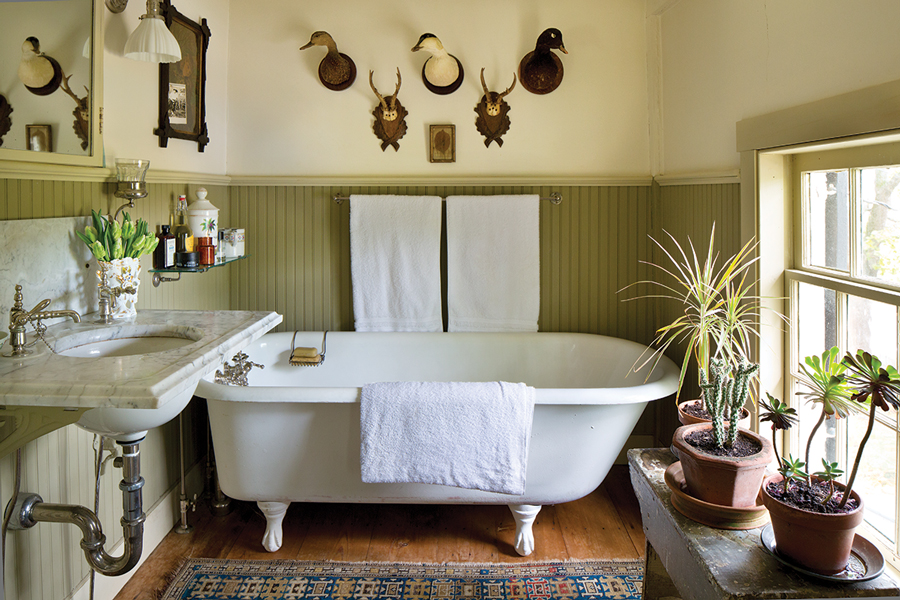
An elephant-trunk toilet with raised ornamentation. Quirky old single-tap faucets marked Hot and Cold. A tower drain tub filler with crazed or cracked porcelain buttons. If you have any such fixtures or fittings in your bathroom, count yourself lucky. As with most old things, however, these nearly irreplaceable antiques may be somewhat the worse for wear after a century of use. That doesn’t mean it’s time to rip them out and replace them.
“With a little bit of service and maintenance, the stuff made 80 or 100 years ago will run for another hundred years,” says John Vienop, responsible for machining and assembly at Bathroom Machineries, a California bathroom-fixture restoration and supply shop. “Pretty much anything you buy today, you’re lucky to get 10 years out of it.”
That goes for fixtures such as sinks, toilets, and bathtubs as well as fittings such as tub fillers and lavatory taps. Century-old faucets may be worn to bare brass gone greenish-grey and fixtures may be cracked, chipped, or crazed, but there’s nothing else like them—perhaps one reason why there’s a booming market for J. L. Mott pedestal sinks and earthenware tubs.
As an example, Vienop says, he recently lifted a 1911 sink basin in the shop. “The thing weighs 110 pounds without the stand. It’s never going to break unless you drop it. A modern sink of equivalent size is 40 pounds. On a good day.”
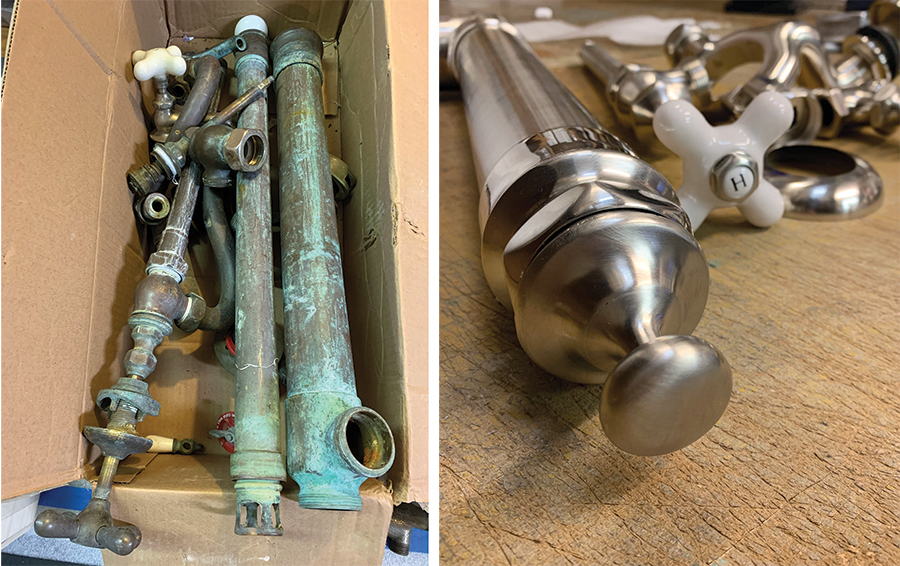
Restore or Replace?
Even replacement parts for vintage fixtures aren’t made as well as the originals, says Lydia Scheller, who co-owns Bathroom Machineries with her husband, Jim Freeman. “We’re finding that porcelain handles made now are lighter and, for lack of a better word, crumblier. They don’t have the substance that vintage porcelain handles have.”
That said, however, some vintage plumbing fixtures dating to after World War II were made with zinc as a base material instead of brass. Those corrode to the point where the original parts aren’t salvageable, Vienop cautions.
Most plumbers will tell you it’s impossible to get parts for what’s missing or broken in your bathroom—even when many of those parts are still available at salvage dealers or venerable hardware stores. Walter Parker of The Old School Plumber typically cherry-picks replacement parts from his 5,000-square-foot plumbing collection, which at the moment includes 10 rib-cage (aka needle) showers. Because the plumbing apparatus is so unwieldy, most were assembled on site by plumbers of the era.
Occasionally Parker has to scramble to find a specific part, like the 1890 new-old stock J. L. Mott shower pan he installed for Karla Pearlstein [“The Rescue of Firehouse 17,” OHJ December 2021]. The rib-cage shower was slightly too big to fit the pan, so he shortened and re-bent all eight of the ribs. Needle showers are treasured for therapeutic whole-body sprays flowing from hundreds of perforations along the ribs. If you’ve never experienced a needle shower, Parker explains that “it’s like having 1,200 feathers hit you all at the same time.”
Vintage parts are often sturdier and longer-lived than contemporary replacements. As an example, Parker mentioned using an 80-year-old J. L. Mott rubber gasket that was still in perfect condition, on a project a few years back.
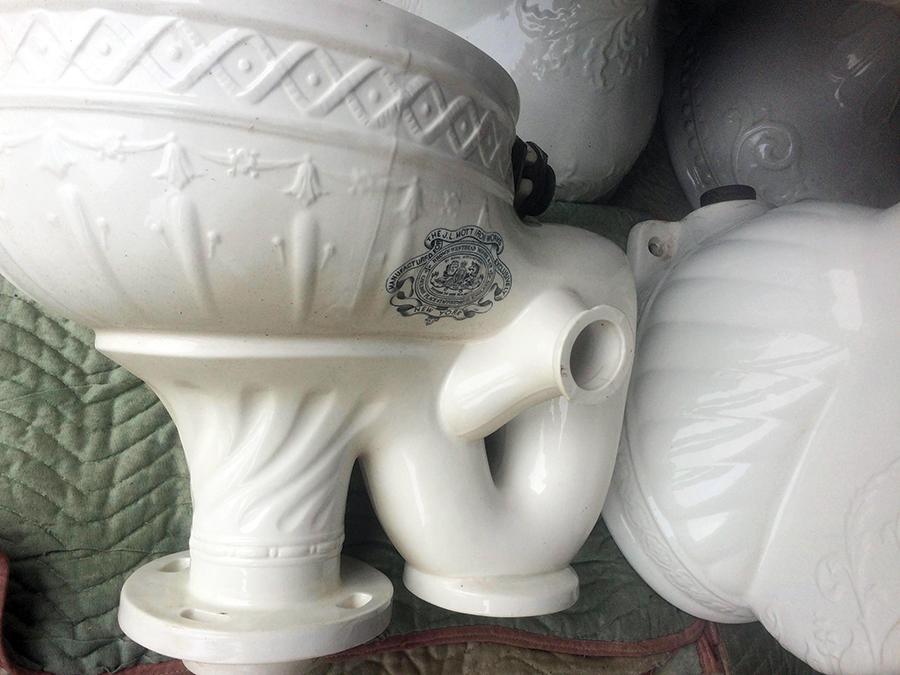
Do Your Homework
Knowing what will work and what won’t often requires expert advice. From pictures alone, a layman can’t necessarily spot the cracks that mean a fixture is unusable: that’s why it’s important to buy from a reputable salvage dealer. If possible, see the sink or tub in person before you buy. Then there’s the question of whether the mechanical parts are still functional. Valves, especially, take the most wear because they regulate the inflow and outflow of water. Threaded pipe fittings, the oldest joining method for plumbing faucets, can vary widely in early fixtures—from as few as three or four threads per inch up to 30 or 40.
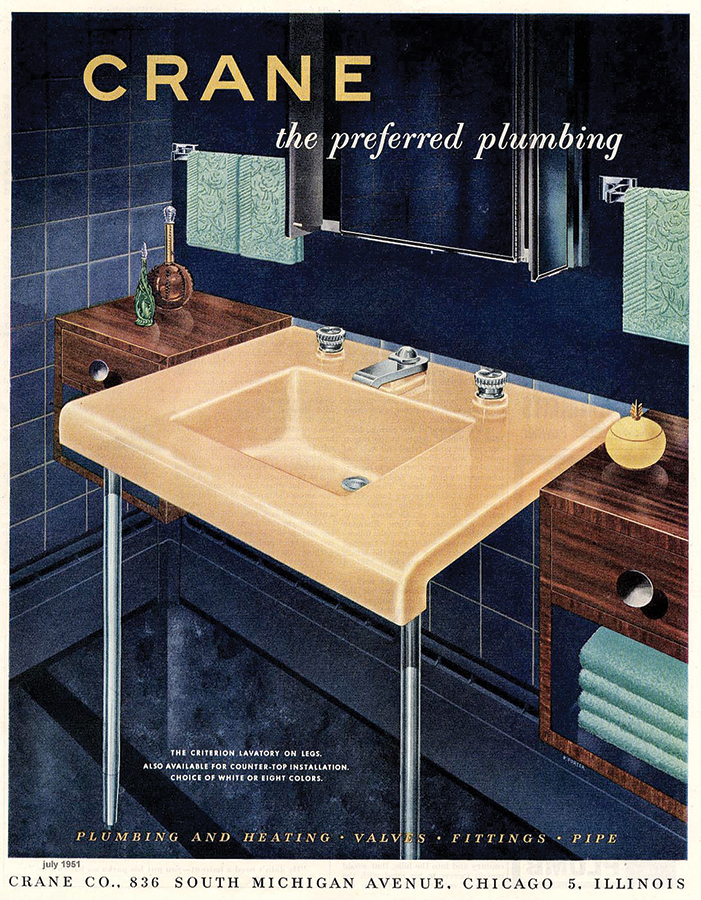
“In pre-World War I faucets, there were no standards,” Vienop says. “Different manufacturers had proprietary thread pitches, so you had to buy everything from that manufacturer.”
The same may hold for fixtures and fittings. One popular post-World War II Crane sink, the Criterion, accepts only a Crane Criterion faucet; no other faucet will work. “Probably once a month, we get someone who has designed everything in the bathroom around a sink, and the installation is all done,” says Scheller. “They come to us and say, ‘I just need a faucet’.”
So do your homework. When you buy a vintage fixture, get the fittings, too, if they are functional and in good condition. Otherwise, you may have an extensive search ahead. Persevere, when even a trusted plumber says it can’t be done for a lack of a part. “Plumbers, we’re finding, are not really hip to what parts are available,” says Scheller, of Bathroom Machineries. “I’m always really happy when I can save a customer from having to remodel their bathroom for lack of a $100 part.”
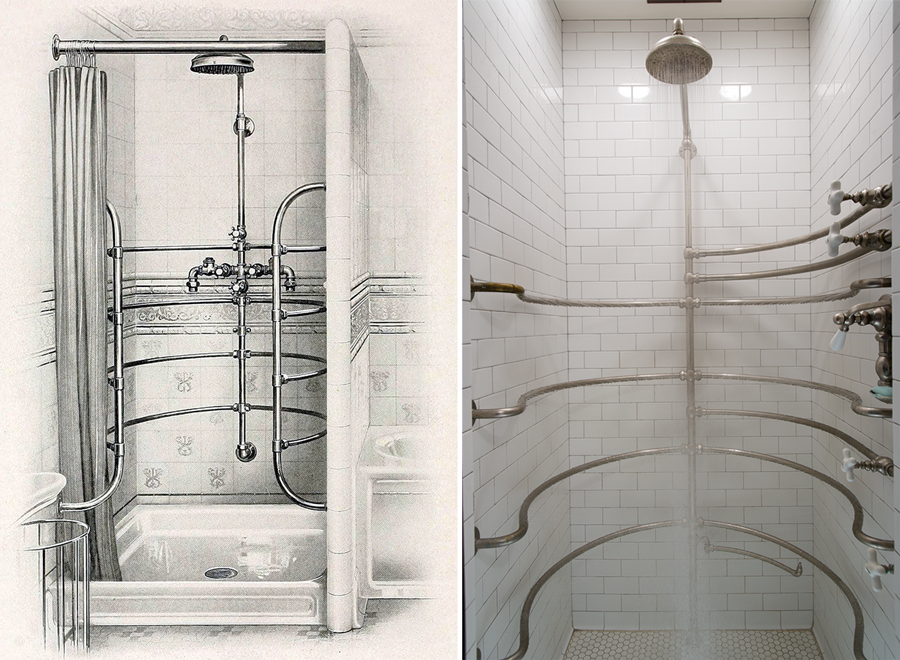
Retrofitting a Bathroom Fixture
First, decide whether you want that needle shower or Fuller lav set reconditioned, or fully restored. At Bathroom Machineries, customers typically opt for full restoration, where the finish on a given piece is stripped down to bare brass, polished, and replated. Other restorers, notably The Old School Plumber and the Plumbing Geek, offer reconditioning, where function is fully restored but the exterior patina remains much the same after corrosion removal and cleanup. When components of a given fixture no longer match, either because of earlier repairs or different exposure conditions, it’s possible to replicate patina. Brian Marrone (the Plumbing Geek), for instance, was asked to refurbish a standing waste assembly where one of two risers was nickel plated while the other was brass. To make them match, the nickel-plated riser was stripped and polished, then fumed with sulfur (don’t try this at home) to re-create the look of dull brass found on the original brass riser.
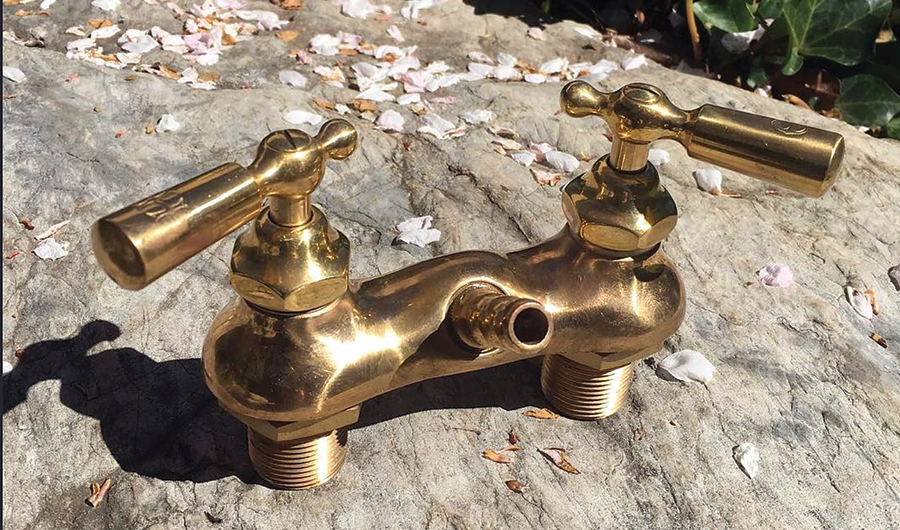
Mixed Plumbing
Many houses have a mix: supply lines of brass, galvanized (zinc-coated) iron, and copper. Vents are traditionally cast iron, drain lines increasingly made of PVC (polyvinyl chloride).
Before the advent of copper plumbing in the late 1920s, brass tended to be used for supply lines in the East and galvanized iron was more prevalent elsewhere, says Walter Parker of The Old School Plumber. Over time, the zinc on galvanized pipes erodes, leading to slow drainage and lower water pressure. Pipes become brittle and susceptible to breakage. When Parker worked at the 1914 Pittock Mansion, in Portland, Oregon, he found (and replaced) galvanized pipes with threads so rotten that simply touching a pipe separated it from the rest of the plumbing.
Brass does not corrode as aggressively as galvanized iron, but it does not have the longevity of copper. “Copper water pipes, soldered correctly, will last 100 years,” Parker says. “That’s not a guess. It’s proven.”
That’s not the case with PVC, which is best used for drain lines. Galvanic corrosion still takes place—where brass fittings make contact with steel clamps, for example. Even copper may corrode in areas with acidic water. Add a neutralizing system to balance the pH.
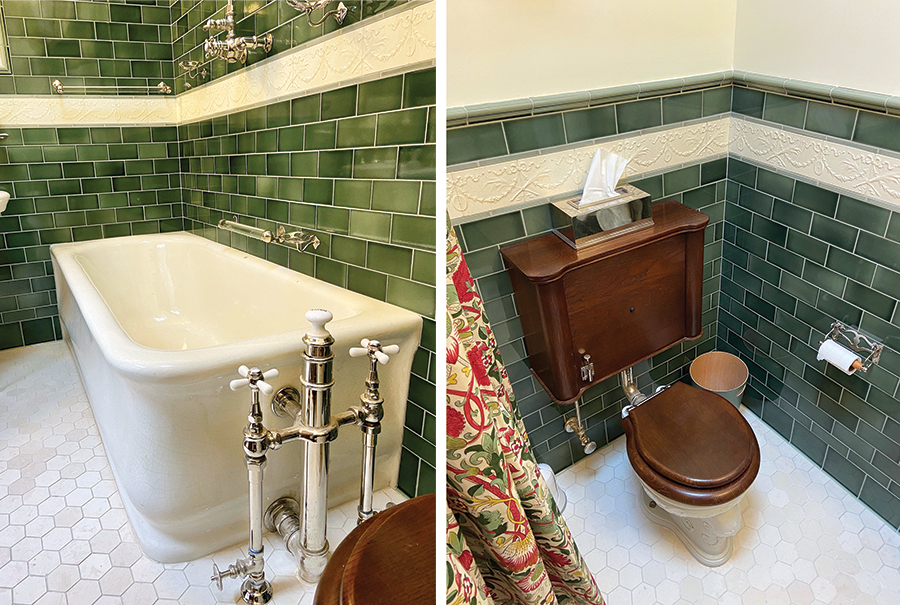
The Importance of Venting
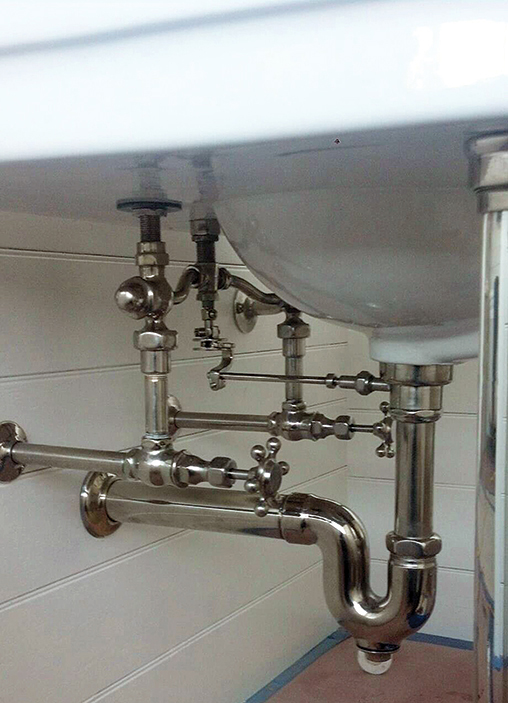
Venting is essential to healthy plumbing. Drain lines that connect to the sewer or septic tank must seal as wastewater leaves the pipes, or you may experience unpleasant—sometimes dangerous—smells.
• The mechanism that does the work here is the lowly trap. The most familiar form is the P-trap, that bend in the pipes beneath the kitchen or bathroom sink. (Other, usually hidden, traps form seals as wastewater leaves the shower, tub, or toilet.)
• The bend allows water and waste to flow through, but traps a small amount of water after each use. This forms a seal that keeps vapors from sewer or septic lines from backing up into the house.
• A trap also allows gases to depart through vent pipes (those cast-iron behemoths usually found in walls). If the house lacks vent pipes (some older homes were built without them), the gases have nowhere to escape and can push the liquid in the trap into the waste system, destroying the seal. Instead of venting outside, fumes enter the house. Gases include explosive methane, so a bad smell is the least of the dangers.
You Might Also Like
Resources
American Standard
americanstandard-us.com
Since 1929
Barclay Products
barclayproducts.com
Vitreous china, fireclay & copper plumbing fixtures
Barber Wilsons
barberwilsons.com
1890s-style taps, showers
Chicago Faucets
chicagofaucets.com
For 100 years a mfr. of durable faucets & fittings
Goof Proof Showers
goofproofshowers.com
Shower-pan installation kits
Harrington Brass Works
harringtonbrassworks.com
Victorian & other period-inspired fixtures, fittings
Herbeau
herbeau.com
Period-inspired fixtures
Kohler
us.kohler.com
Fixtures & fittings
LeFroy Brooks
lefroybrooks.com
Fixtures & fittings in Edwardian, Art Deco & MC Modern
Mitchell Andrus Studios
missionfurnishings.com
Custom-made medicine cabinets
Renovator’s Supply
rensup.com
Hard-to-find fittings & fixtures
Sheldon Slate
sheldonslate.com
Custom sinks & countertops; restoration
Signature Hardware
signaturehardware.com
Bath fittings & fixtures
Strom Living
stromliving.com
Period-inspired bath fittings & fixtures
Urban Archaeology
urbanarchaeology.com
Salvage; estate-level tubs, sinks, consoles, accessories, lighting
Victoria + Albert
vandabaths.com
British-made tubs, washstands, taps
Vintage Tub & Bath
vintagetub.com
Period-inspired bath fittings







